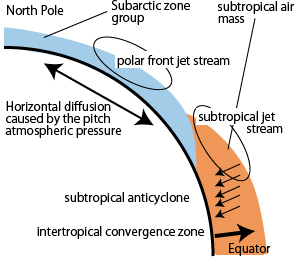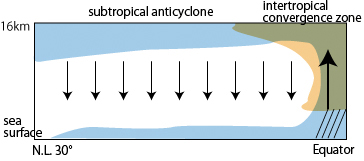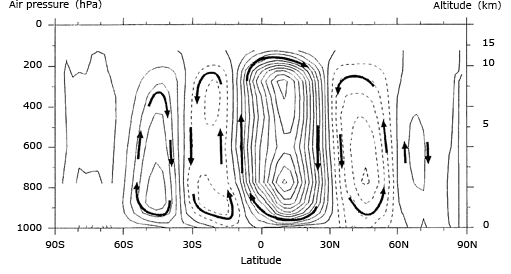Wind Speed on Cubic Earth will be Slow
In the cubic Earth, the shape of the sea surface is a part of a sphere. In this sense, the atmosphere over the sea surface on the cubic Earth is similar with that on the real Earth. In the real Earth, the tropical Pacific is almost covered by the ocean.
Therefore, the atmosphere over the ocean on the cubic Earth is expected to resemble the atmosphere over the tropical Pacific on the real Earth. However, the sea level pressure of the cubic Earth is 9 atm which is greater than that of the real Earth (1 atm). What kind of effects does the high sea level pressure bring in the atmosphere?
The high atmospheric pressure means that the density of the air is higher than that of the sea level in the real Earth. The kinetic energy of the air mass is proportional to the density of the air under the same wind speed.
Conversion from thermal energy to kinetic energy is the driving force of the atmospheric circulation. The thermal energy is given by the sun. The amount of the solar radiation for the cubic Earth is expected to be same with that of the real Earth. Therefore, the kinetic energy given to the atmosphere of the cubic Earth is expected to be also same with that of the real Earth. This means that the wind speeds of the atmosphere at the sea level are slower than those of the real Earth.
Mechanism of Atmospheric Circulation


In the real Earth, the global atmospheric circulation consists of the circulation of the sub-polar air mass and the circulation of the sub-tropical air mass, depending on latitudes as shown in Fig. 5. The tropical atmospheric circulation is the circulation of the sub-tropical air mass. This circulation is called "Hadley circulation". The Hadley circulation consists of the subtropical convergence zone located in low latitudes and the adjacent subtropical high pressure zone as shown in Fig. 6. The air mass that ascents in the subtropical convergence zone descends in the subtropical high pressure zone. The similar circulation system is expected to be created in the atmosphere over the ocean in the cubic Earth.
Many cumulonimbi repeat generation and dissipation in the subtropical convergence zone. Intense vertical airflows are generated within cumulonimbi. The air transported near the tropopause spreads horizontally in both northern and southern hemispheres and descents gradually in the subtropical high-pressure zone. The weather in the area covered by the subtropical high-pressure zone is fine without clouds. The sun light reaches to the sea surface and enhances evaporation of the water vapor from the sea surface by heating it. The water vapor is brought to the subtropical convergence zone and ascends up to the tropopause inside of cumulonimbi.
In Fig. 6, cumulonimbi are located near the equator. In fact, they are generated also apart from the equator. The latitudinal belt where most of the cumulonimbi are generated varies depending on seasons. Therefore, the circulation of the tropical atmosphere looks like that shown in Fig. 7, rather than that shown in Fig. 6.




